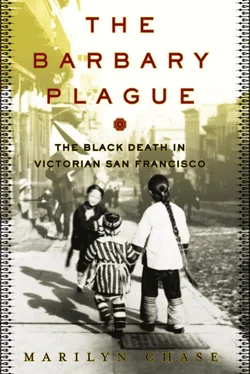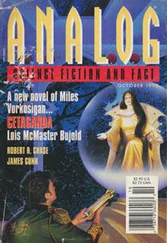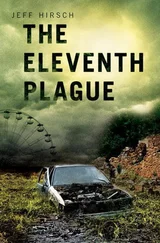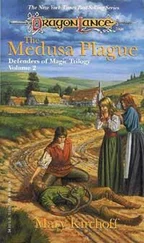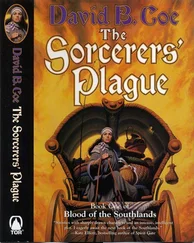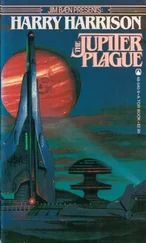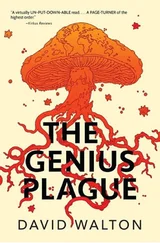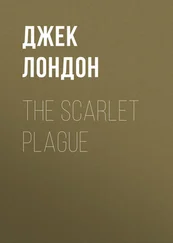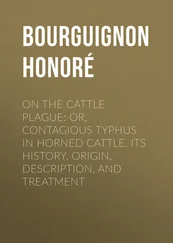So the Australia ’s bladelike hull turned away from Angel Island toward the port of San Francisco. With a touch of unease, the quarantine officers watched as the V-shaped spume widened in her wake. Easing into the dock, the Australia delivered the sanitized bags of her sixty-eight passengers and a shipment of fumigated mail, along with some four-legged stowaways that, somehow, escaped detection. 22

THE NEW YEAR OF 1900ushered in dangerous times. In San Francisco, it was, as always, a holiday with two faces. Downtown, white celebrants raised their usual end-of-year ruckus. In the streets of Chinatown, a shadow fell over the Lunar New Year, in an ominous prologue to the year ahead.
Rain spattered the boardwalks on New Year’s Eve. When the skies cleared, the merrymakers came out. A band of maskers gathered on the corner of Market and Kearny streets, just below Union Square and Chinatown. Blowing horns and clanging cowbells, they hurled confetti and thrashed passersby with evergreen boughs left over from Christmas. Then the celebration turned ugly. Charging north up Kearny for five blocks, the carousers reached Chinatown and started grabbing Chinese musical instruments from the shops, banging the gongs, and blasting away on the winds. The din was so loud, it pierced the paneled recesses of the nearby men’s clubs. Bystanders cringed to hear the strains of “Auld Lang Syne” mingling with what sounded like the minor wails of a Chinese funeral band. 1
But funereal sentiments were very much in order in the year 1900. For death was the uninvited guest at this New Year’s feast although, like the maskers, it came in disguise.
In Chinatown, the approach of the Chinese New Year—the turning over of the lunar calendar in February—usually was heralded by the hiss and bang of firecrackers, warding off demons and trailing smoke that pricked the nostrils with excitement. Sidewalk stands traditionally sold stacks of juicy sugarcane and mounds of crackling melon seeds. To perfume the spring banquet tables, people would buy pots of narcissus bulbs, crowned with stiff green shoots and buds that burst into white trumpets with a center of gold that symbolized good fortune. People wearing silk tunics in peacock hues would call on family and friends with gifts and cakes. Children in embroidered skullcaps and jeweled headdresses would parade hand in hand.
All this would happen in a festive Lunar New Year. But not in this year of 1900. Instead of fireworks, gunfire rang through the streets, and the alleys ran with blood. Gang warfare had struck again. As punishment, the San Francisco Police Department cracked down on the whole district, canceling all holiday celebrations. Sidewalks were barren of flowers, parties were banned, and the streets were still.
So the Chinese New Year crept in, as gray and drab as its namesake on the great wheel of the astrological calendar, for 1900 was the Year of the Rat.
According to Chinese astrology, people born in the Year of the Rat are clever and resourceful. Family loving to the point of being clannish, rats are also frugal, sharp-witted, and good companions in adversity. 2
This year, however, rats were to become harbingers of evil. Merchants awoke to find grizzled pelts of dead vermin in their alleyways and courtyards. Dull-eyed, stiff, shaggy cadavers sent a shudder through the neighborhood.
In the old country, they portended epidemics—in any house where rats had died, human deaths were sure to follow. In 1792, the poet Shih Tao-Nan had written:
The coming of the devil of plague
Suddenly makes the lamp dim,
Then it is blown out, Leaving man,
ghost and corpse in the dark room. 3
In the old country, households would flee at the sight of a dead rodent. But here, there was nowhere else to go. Discrimination hindered Chinese from living elsewhere in town. Fearing an avalanche of bad luck in the New Year, they filed complaints with the city. As usual, nothing was done. Many people considered rats as the inevitable companions of human settlements, even as natural garbage collectors performing a salutary service. And this was, after all, Chinatown.
March blew in, raw and unsettled. In the late winter mist, a fever stole up from the waterfront. It skulked in on four legs, and invaded the bunks of the working poor who slept layered in dense tenements.
Many kinds of illness, from typhoid to diphtheria, raked the city’s poor. But this disease was different. This was the scourge that for centuries had come in the wake of a rat invasion. When the rats died, the fleas abandoned their corpses, seeking new blood, human blood, in the warrens of the poor. The disease attacked with a violent rush of fever and shuddering chills. A headache seemed to core out the skull. Victims weakened and took to their beds. Penetrating pains raked the back and limbs. Red lumps erupted from the armpits and groin, excruciating to the touch. Hemorrhages would burst beneath the skin, causing black bruises. Senses wandering, the sick would chatter and fidget restlessly, plucking at their bedclothes. Their agitation subsided only as they sank into a coma, ending in death.
Late on the afternoon of Tuesday, March 6, 1900, the phone rang at the police headquarters. A dead man was in the Chinese undertaker’s shop at 814 Clay Street, and the police physician needed to issue a burial certificate. The corpse bore no gross signs of foul play, no bulletholes or knife wounds, but the man had died of a violent disease.
The dead man’s name was Wong Chut King. He was a forty-one-year-old lumber salesman, living the lean life of a bachelor laborer in the Globe Hotel at 1001 Dupont Street on the corner of Jackson. The Globe Hotel, a once fashionable spot turned flophouse, was known as the “Five Stories.” Its cramped cells sheltered hundreds of Chinatown’s workingmen, sharing their life of expansive dreams and narrow bunks in their adopted land.
Now he was middle-aged and sick. When he felt too weak to drag himself to work at the lumberyard, Wong Chut King took to his spartan quarters at the Globe. The gaslight shed a weak gold halo over the bunk where Wong lay, drawing his knees up to cradle a knot of pain that pulsed in his groin. He shifted uneasily on his cot. Local healers offered herbs to ease his aches, ascribed to a cranky middle-aged bladder. A fierce fever made him sweat and shiver by turns. He threw up his last meager meal. He fell into a fiery delirium.
As his fever soared, his mind became unmoored, floating freely in and out of consciousness. Where Wong wandered in his delirium—back to his native village or on to some fever dream of Gold Mountain—only he could see. Perhaps in febrile visions, Wong saw his barren cell pulse with unearthly colors. Perhaps he saw himself as a young man, leaving his village of Pei Hang, in the county of Ling Yup. 4Crossing the Pacific to Gold Mountain, he discovered a town more gray than gold. Perhaps he saw himself in the sea of Chinatown bachelors, growing old an ocean away from their families, easing their bones by visiting “hundred-men’s-wives” in brothels called “green mansions.” 5
Now, as Wong sank, the bacteria flourished in his glands and blood. Although it takes few plague bacteria to cause infection, the flea that bit Wong probably injected a lethal dose of fifteen thousand bacteria. Like most victims, he likely would have scratched at the bite, driving the germs deeper. At once they multiplied, spreading from the flea bite on his leg up toward the lymph node in his pelvis. Lymph glands, the sentries of the immune system, struggled to contain the invaders. The lymph node grew swollen, inflamed, and tender to the touch. His fever rose. His tongue turned white and furry, and sores crusted his lips. Eventually the infection spilled over into his bloodstream. Giant germ-eating cells—macrophages—rushed to devour the plague bacteria but were overcome. Some bacteria were killed by antibodies that converged on the scene. But as they died, the bacteria detonated a final weapon—deadly toxins. These poisons ran riot in the blood, vandalizing the tissues of the heart, liver, and spleen. Under this assault, the organs began to hemorrhage and disintegrate. Vessels dilated, and blood pressure plunged. Septic shock set in. Wong Chut King descended into a coma. 6
Читать дальше
